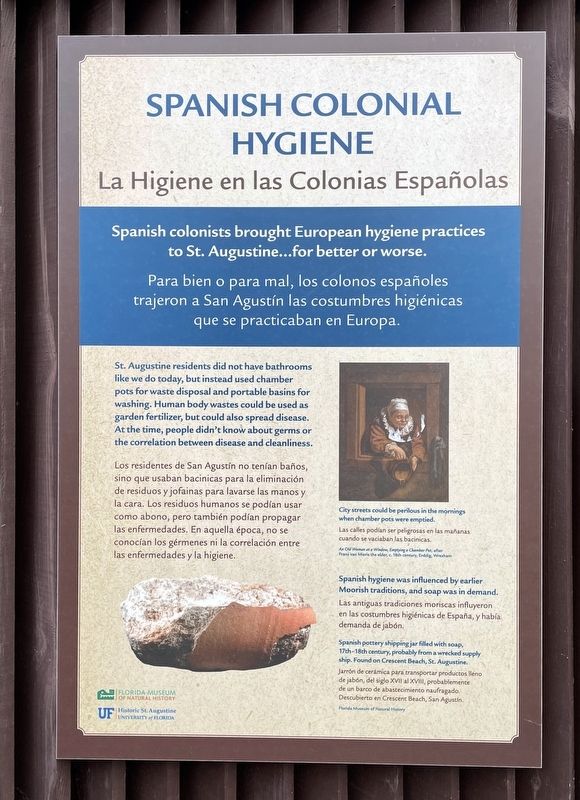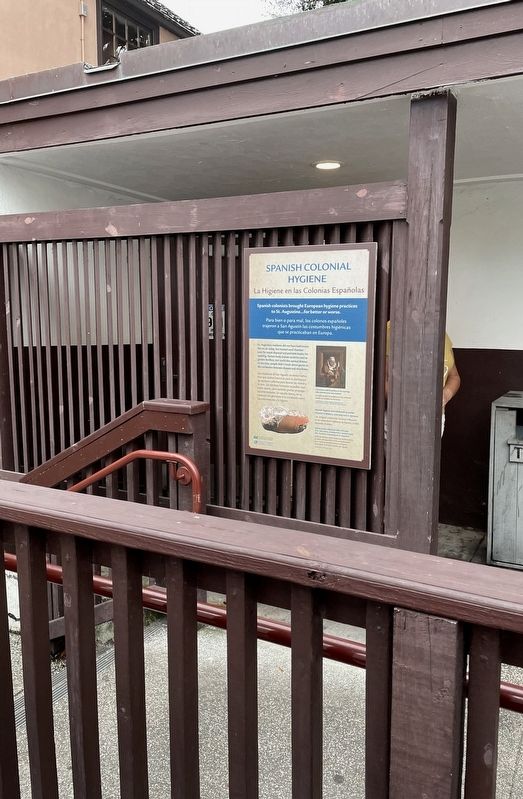St. Augustine in St. Johns County, Florida — The American South (South Atlantic)
Spanish Colonial Hygiene
La Higiene en las Colonias Españolas
Para bien o para mal, los colonos españoles trajeron San Augustín las costumebres higiénicas que se practicaban en Europa.
St. Augustine residents did not have bathrooms like we see today, but instead used chamber pots for waste disposal and portable basins for washing. Human body wastes could be used as garden fertilizer, but could also spread disease. At the time, people didn’t know about germs or the correlation between disease and cleanliness.
Los residentes de San Austín no tenían baños, sino que usaban bacinicas para la eliminación de residuos y jofainas para lavarse las manos y la cara. Los residuos humanos se podían usar como abono, pero también podín propagate las enfermedades. En aquella época, no se conocían los gérmenes no la correlación entre las enfermedades y la higiene.
(Captions)
City streets could be perilous in the mornings when chamber pots were emptied.
Las calles podian ser peligrosas en las mananas cuando se vaciaban las bacinicas.
An old woman at a Window, Emptying a Chamber Pot, after Frans van Mieris the elder, c. 18th century, Erddig, Wrexham
Spanish hygiene was influenced by earlier Moorish traditions, and soap was in demand.
Las antiguas tradiciones moriscas influyeron en las costumbres higiénicas de Espana, y habla demanda de jabon.
Spanish pottery shipping jar filled with soap, 17th-18th century, probably from a wrecked supply ship. Found on Crescent Beach, St. Augustine.
Jarrón de cerámica para transportar productos lleno de jabón, del siglo XVII al XVIII, probablemente de Un barco de abastecimiento naufragado. Descubierto en Crescent Beach, San Agustín.
Florida Museum of Natural History
Erected by Florida Museum of Natural History and Historic St. Augustine, University of Florida.
Topics. This historical marker is listed in these topic lists: Colonial Era • Notable Places • Settlements & Settlers. A significant historical year for this entry is 1565.
Location. 29° 53.794′ N, 81° 18.798′ W. Marker is in St. Augustine, Florida, in St. Johns County. Marker can be reached from St. George Street, 0.1 miles south of Fort Alley, on the left when traveling south. Marker located at the entrance to the public restrooms on St. George Street. Touch for map. Marker is at or near this postal address: 42½ St George Street, Saint Augustine FL 32084, United States of America. Touch for directions.
Other nearby markers. At least 8 other markers are within walking distance of this marker. La Florida's El Camino Real (here, next to this marker); Salcedo House (a few steps from this marker); British Colonial Hygiene (a few steps from this marker); Every Drop Counts (a few steps from this marker); Florencia House (a few steps from this marker); The Minorcan Heritage (a few steps from this marker); De Hita-González Houses (a few steps from this marker); Triay House (a few steps from this marker). Touch for a list and map of all markers in St. Augustine.
Credits. This page was last revised on December 17, 2021. It was originally submitted on December 16, 2021, by Brandon D Cross of Flagler Beach, Florida. This page has been viewed 234 times since then and 44 times this year. Photos: 1, 2. submitted on December 17, 2021, by Brandon D Cross of Flagler Beach, Florida. • Bernard Fisher was the editor who published this page.

